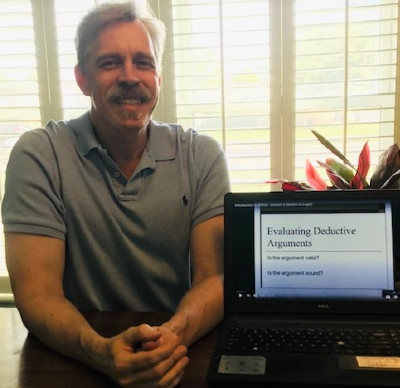Amarillo, College issued the following announcement on May 12
Educators generally prize students who actively engage in the learning process, but for faculty whose lessons depend upon lively discourse of conflicting moralities, scholarly engagement is paramount.
Dr. Michael Hannen’s model for Introduction to Ethics is a case in point.
“We get into contemporary moral debates about topics such as capital punishment and abortion, said Hannen, instructor of philosophy and coordinator of the humanities at Amarillo College.
“Student engagement is essential.”
That’s why, when AC’s academic community transitioned to a remote learning environment in response to the global pandemic, Hannen took a road less traveled.
While most faculty use AC’s ubiquitous video-conferencing resources to present real-time lectures, Hannen has embraced a “flipped” classroom approach that ensures more time for students to experience the interpersonal communication upon which his delivery of ethics relies.
The flipped-classroom approach is where an instructor pre-records lectures that students watch in preparation for regularly scheduled virtual class meetings.
“I was concerned that by filling our class times with lectures we would not have enough time left for discussion, for breaking into groups and making follow-up presentations,” Hannen said. “So, I recorded the lectures and posted them to my YouTube channel. Students can go through them at their own pace.”
Appropriately equipped with conceptual knowledge, Hannen’s students now make the most of their time together on virtual platforms like Google Meets and Blackboard Collaborate by taking part in group projects and in-depth discussions.
“When we meet virtually, it is mostly discussion,” Hannen said. “Not only am I keeping my students engaged, but this move to remote learning has had some advantages.
“I’ve noticed that some students are actually less hesitant to speak up when there is that degree of distance.”
Hannen notes that his students possess varying levels of technology, but he says it has not impeded his efforts to prioritize virtual classroom engagement. For example, some without access to video cameras just listen in.
“If I can’t see their faces, I’ll call on them anyway, and they can type their questions (in a chat box) if they like,” Hannen said. “In a traditional classroom I’m constantly scanning faces to assess their level of engagement.
“But it’s surprising how fast you can get used to a new way of doing things,” he said. “I believe my students have gotten the hang of things just fine, even the ones with steeper learning curves. I believe I’m keeping them engaged.
“Everyone is collegial and respectful. I do miss the traditional classroom experience; however, the students have adapted well. This definitely works.”
Original source can be found here.

Source: Amarillo, College



 Alerts Sign-up
Alerts Sign-up